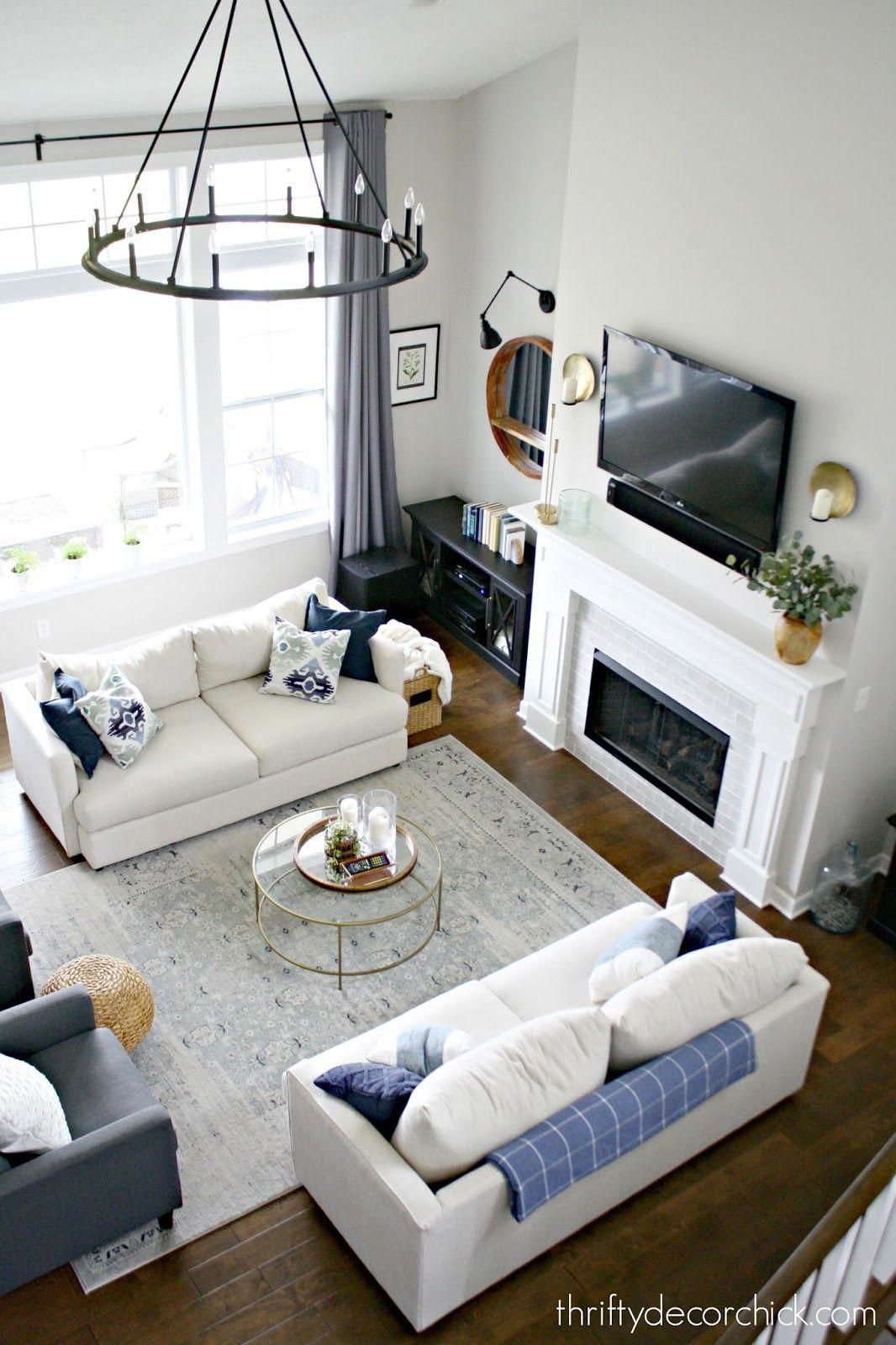Having two sofas in your living room can elevate both comfort and style. This comprehensive guide explores how to achieve this, offering layout ideas, design tips, and solutions for various spaces and budgets.
Styling Your Space with Two Sofas
Adding a second sofa can transform your living room into a haven of comfort and style. Whether you envision a cozy family gathering spot or a chic entertaining area, two sofas can make it a reality. Let’s explore how to make this design dream work for you.
Planning Your Sofa Layout
Before purchasing new sofas, careful planning is essential. Consider your living room’s size, shape, and how you use it. Do you frequently host movie nights, game nights, or book club meetings? Accurate measurements are crucial to ensure both sofas fit comfortably without overcrowding the room. Here are a few popular arrangements:
- Facing Sofas: This classic arrangement fosters conversation and creates an intimate atmosphere, ideal for smaller gatherings. Consider adding a coffee table in the center to enhance functionality. [https://www.wavesold.com/2-car-garage-plans]
- L-Shaped Setup: Perfect for open-plan living rooms or larger spaces, an L-shaped arrangement defines separate areas for different activities, such as watching TV and conversing.
- Parallel Arrangement: This symmetrical layout works well in long, narrow rooms, positioning sofas along the longer walls. Ensure sufficient space between them for comfortable passage.
- Wide-Angle Arrangement: In spacious rooms, angling the sofas creates a relaxed, casual feel. Accent pieces can fill the remaining space and enhance visual appeal.
Visualize these layouts using painter’s tape to determine the optimal arrangement for your space and lifestyle.
Establishing a Focal Point
Every living room benefits from a focal point – a feature that draws the eye and anchors the space. This could be a fireplace, a large window with a view, or a striking piece of art. Your sofas can either complement an existing focal point or create a new one. For instance, positioning sofas to face a fireplace creates a warm and inviting ambiance, while orienting them towards a TV optimizes the space for movie nights.
Defining Your Aesthetic
Two sofas provide an excellent opportunity to explore different styles and colors. Matching sofas offer a cohesive, polished look, while mixing and matching can create a unique, eclectic vibe. Pairing a modern sofa with a vintage loveseat, for example, adds character and visual interest. Accessorize with rugs, throw pillows, and a coffee table (or two!) to harmonize the sofas and complete the look.
Selecting the Perfect Pair
Choosing the right sofas is paramount. Consider various types, such as sectionals, loveseats, or even a chaise lounge, depending on your space and seating requirements. Pay close attention to sofa dimensions; a bulky sectional might overwhelm a small room, while a petite loveseat could get lost in a larger one. Upholstery is another key factor. Leather offers durability and easy cleaning, making it suitable for families with children or pets. Fabric provides a wider range of colors and patterns, while velvet adds a touch of luxury. Select a material that aligns with your lifestyle and décor.
Can You Put Two Sofas in a Living Room?
Absolutely! While it might seem like a lot, two sofas can enhance a living room’s comfort, style, and functionality. Careful planning is key to achieving a balanced and inviting space. This entails considering room size, layout, furniture choices, and accent pieces.
Room size is the primary factor. Two sofas work well in larger rooms, but they can also fit in smaller spaces with strategic planning. Room shape also plays a role. Standard square or rectangular rooms offer versatility in layout options, while irregularly shaped rooms might require creative solutions.
Consider how you use your living room. Is it primarily for movie nights and gatherings, or more for quiet conversations and reading? This will inform the best sofa placement. The height of the sofa legs is another subtle yet impactful detail. Raised legs create the illusion of more space, particularly helpful in smaller rooms.
Don’t forget the unifying power of a rug. A rug anchors the seating area and connects the sofas visually, creating a cohesive space. Selecting a round coffee table can improve flow and movement, while a rectangular one offers more surface area for displaying books or decorative items.
What is the 2/3 Rule Sofa?
The 2/3 Rule is a design guideline that promotes balanced proportions within a room. While not a strict rule, it offers a framework for creating visual harmony. It can guide furniture choices, placement, and the selection of artwork and rugs.
One application involves the sofas themselves. A classic combination is a three-seater sofa paired with a two-seater loveseat, embodying the 2/3 ratio in seating capacity. The rule also suggests that the sofa should occupy approximately two-thirds of the wall it’s against, preventing the wall from feeling too empty or the room too cramped.
| Element | 2/3 Rule Application |
|---|---|
| Sofa Combination | Two-seater sofa (loveseat) paired with a three-seater sofa |
| Sofa Placement | Sofa occupies roughly two-thirds of the wall length |
| Artwork above Sofa | Artwork width is roughly two-thirds of the sofa length |
| Rug Size | Large enough to anchor the front legs of main seating pieces |
It’s important to note that some designers might interpret and apply the 2/3 Rule differently, adapting it to each room’s unique characteristics. It ultimately serves as a tool for achieving visual balance, with room for personal preferences.
How to Coordinate Two Different Sofas
Coordinating two different sofas can add personality and visual interest to your living room. It’s about finding the right balance of coordination and contrast.
1. Size and Measurement: Before selecting sofas, measure your living room to determine the appropriate size for each piece. This prevents overcrowding and ensures comfortable traffic flow.
2. Harmony in Style, Color, and Fabric: The sofas don’t need to be identical, but they should share some common elements in terms of style, color, or fabric. This could involve similar lines, a shared color palette, or coordinating throw pillows and blankets to create a cohesive look.
3. Sofa Arrangement: The arrangement dramatically impacts the room’s feel. An L-shape or facing sofas fosters conversation, while a parallel arrangement creates a more formal setting. Consider the room’s function and desired interaction when choosing the layout. [https://www.wavesold.com/2-car-garage-plans]
4. The Role of Accessories: Pillows and throws add pops of color, texture, and personality, tying the look together. Using pillows that incorporate both sofa colors on each piece helps bridge the gap between them.
5. Unifying with a Rug: A rug defines the seating area, anchors the furniture, and creates a visual connection. Ideally, the front legs of both sofas should rest on the rug for a grounded, cohesive feel.
6. Enhancing with Plants and Artwork: Plants add life and vibrancy, while artwork personalizes the space. A large piece above a sofa or a gallery wall adds character and visual interest.
There are various approaches to furniture coordination, and ongoing research suggests personal preferences are paramount. Some experts believe contrasting colors create a dynamic atmosphere, while others favor a similar color palette for a calmer feel. The best approach is the one that resonates with you and complements your home.
- Greenhouse Storage Shed Combos: Your Guide to Combining Growing and Storage - April 21, 2025
- Greenhouse Shed Combo: Design, Build & Grow Year-Round - April 21, 2025
- Gingham vs. Plaid: What’s the Difference? A Complete Guide - April 21, 2025










